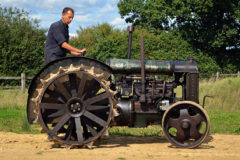Original Muir-Hill muscle
Posted by Chris Graham on 14th May 2020
James Connolly finds a genuine example of some original Muir-Hill muscle, in the form of the popular 121 Series II model.

Original Muir-Hill muscle: Despite the equal-sized wheels, the tractor’s turning radius is just 16 feet; impressive for a machine of this nature.
Brothers Ken and Malcolm Cooke, from Newtownards in Co. Down, are keen Muir-Hill enthusiasts. When working as agricultural contractors, they used various Muir-Hill models to undertake all types of work, including cutting silage and ploughing, as well as with home-built, twin-axle manure spreaders, and to pull 1,500-gallon, Fleming slurry tankers. The tractors were held in high regard by the Cooke brothers, and were viewed as tough and robust machines.
This particular 121 Series II is in original condition, and has just under 2,000 hours on the clock. A factory order was placed for the tractor on February 7th, 1977, by Muir-Hill dealer, TBF Thompson Ltd of Garvagh, Co. Londonderry. The tractor was built at the Muir-Hill factory in Bristol Road, Gloucester which, at the time, formed part of Babcock & Wilcox Ltd. The machine was completed and despatched to Northern Ireland on May 5th, 1977.
The arrival
The dealership paid £11,218.19 for the tractor, and it arrived at the company’s premises, with another 121, on May 14th. It was then sold to the Miller brothers of Farlow Farm in the Roe Valley, Limavady, where it was delivered on July 25th.
One interesting point about the tractor’s BIW 8944 registration number is that the DVLA in Coleraine issued a tax book with February 1st, 1978, as the tractor’s first date of registration. Ken’s 121 was built in the final year of Series II tractor production, in 1977, when its main rivals in the marketplace were the County 1164 and the Roadless 120.
This 121 has quite a few extras fitted, including twin assistor rams, two double-acting spool valves, a pick-up hitch, Dual Power transmission and a full set of underslung nose weights. It also has an extended strengthening frame fitted between the rear axle housing and the engine. This was an optional extra fitted to Muir-Hill tractors, if the machine was to be used with heavy equipment such as ploughs or swan-neck dump trailers.
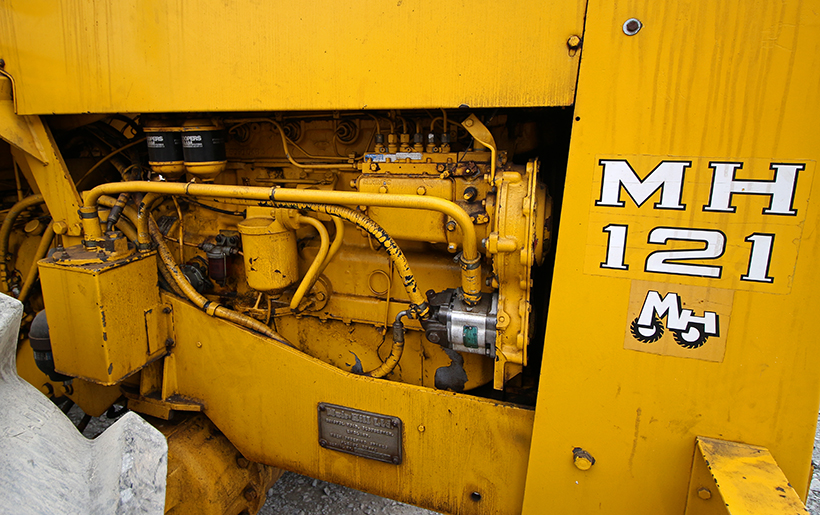
The Ford 2715E six-cylinder engine produced 121hp, and used a Simms Minimec injection pump.
Ken’s Muir-Hill 121 is also fitted with a 1,000rpm, single-speed power take-off, with 21-spline shaft. The main reason for this was that the Miller brothers used the tractor to drive a large power harrow. These power-sapping pieces of arable kit were commonly fitted with 1,000rpm gearboxes on the larger-specification machines.
The power take off was available in this specification from the Muir-Hill factory by changing the PTO gear set from the standard 540rpm gears, to a 1,000rpm gear set. In 1978, the new Series III tractor range became available, with a two-speed power take-off. This was achieved by removing a circlip that held the power take-off shaft in the housing, and swapping the shaft to either the 540rpm or 1,000rpm type. As you would expect, due to the origins of Muir-Hill tractors, this was also available on the Ford 7600 at this time.
Well cared for
The Miller brothers also used the 121 with a Kverneland four-furrow reversible plough. With twin assistor rams fitted, plus the extended strengthening frame; the tractor was more than capable of handling this type of implement. At some point, the Millers also fitted white Ford rear wheel weights.
The 121 was extremely well looked after by the Miller brothers and, apart from ploughing and power-harrowing, the tractor was lightly used during its working life on the farm. It remained in their hands until about 2005, when it was sold to local agricultural machinery dealer, DA Forgie, of Limavady.
When talking to David Forgie, he said he remembered this tractor very well and that today it would be very difficult to find another Muir-Hill with such low hours and in such good, original condition. Looking back, he regrets selling the machine and, with the benefit of hindsight, feels he should have kept it for himself. Nevertheless, the 121 was sold to Ken and now forms part of his Muir-Hill collection.
When he purchased the tractor it was fitted with factory-supplied Dunlop tyres but, unfortunately, cracking meant they had a tendency to puncture easily. So the decision was taken to fit new, 16.9-34 tyres but, apart from this, the tractor is as it was in 1977.
In 1972, Muir-Hill replaced the very popular 101 model with the new 121. Using the same Ford 2715E industrial engine, the 121 had an output of 121hp. The new Series II models were fitted with a new cab featuring two sliding doors. This new cab was more of an integral part of the tractor, rather than an add on, which had been the case with the older, 101 model.
Three steps to heaven!
To enter the cab, the driver must climb three steps on either the left- or right-hand-side of the tractor, and the door then slides open to allow you to take up your driving position in the very comfortable Bostrom seat.
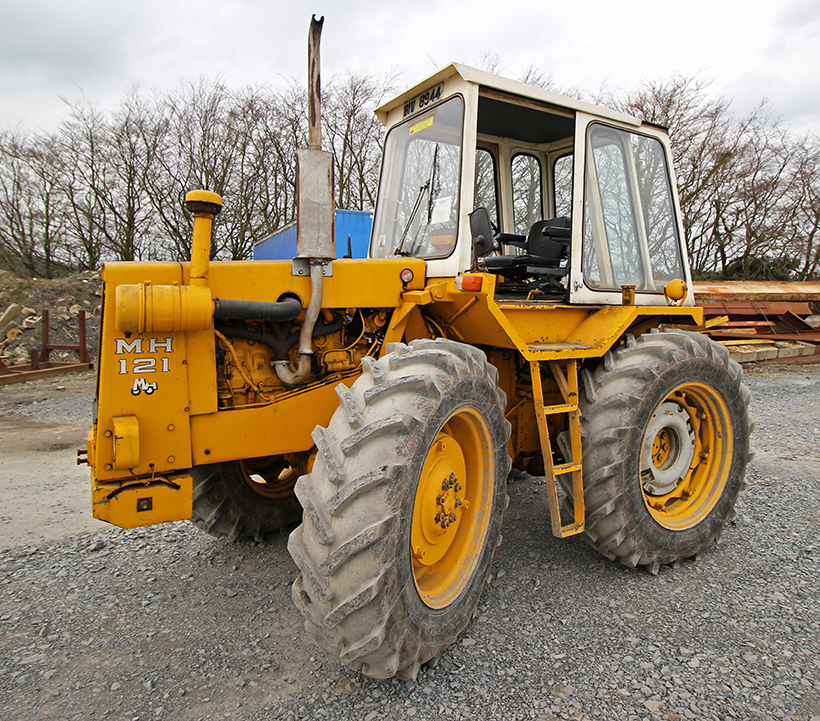
The steps may have been narrow, but access to the cab was good, thanks to a sliding door on each side.
The first thing that grabs your attention is the elevated driving position, which gives you a commanding view of your surroundings. Also, the extensive use of glass in the cab gives you a good view of any implement or machine that you might be using. All controls, including spool valves, hydraulic quadrant, two floor-mounted gear levers, dash instrument panel and Dual Power lever, fall easily to hand.
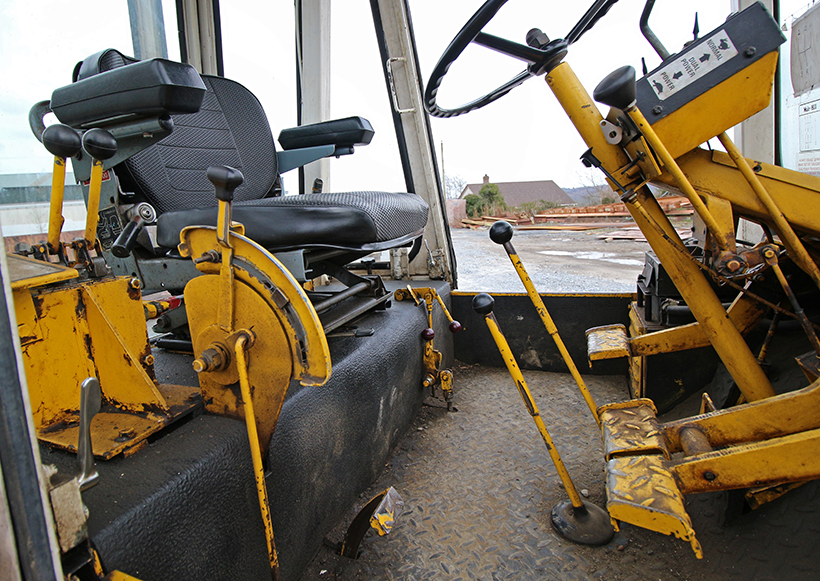
The flat-floor cab is impressive, but is let down slightly by the mid-mounted gear levers.
The 121 is easy to drive and straightforward to operate. The view from the front screen is dominated by the large, square-shaped bonnet, under which is fitted the Ford six-cylinder engine. The Muir-Hill 121 tractor was also available in industrial specification, where it proved to be a popular machine with construction and civil engineering companies. These tractors could be fitted with front-mounted dozer blades, combined with a swan-necked dump trailer, making the tractors formidable machines. TBF Thompson Ltd sold quite a few machines with this format, during its time as the main dealer in Northern Ireland.
Another interesting feature of the Muir-Hill 121 Series II is the location of the fuel tank, which sits directly under the cab floor. This shallow, rectangular tank holds 40 gallons, and is strategically placed above the rear axle for weight distribution. It’s fed by a filler neck in the left-hand side mudguard.

The dash panel is minimal, yet functional.
Very impressive
While taking photographs of the Muir-Hill in action, I had the opportunity to plough with the tractor using a Bamford five-furrow conventional plough. In heavy soil conditions, it handled the plough well – the engine was lively and had good low-down torque characteristics. Ploughing in low fourth, the tractor had good grip levels and, when the going got tougher ploughing uphill, a simple pull of the Dual Power lever into low meant the 121 kept pulling.
When arriving at the headland, the stand-out feature of the Muir-Hill is the turning circle. In my humble opinion, this is as good as any modern-day tractor. Bearing in mind that it has equal-sized wheels, it’s very impressive and will turn in a remarkably small area.
Sales literature for the 121 states that its turning radius is just under 16 feet, without the need to touch the independent brakes. The front axle design is key to the Muir-Hill’s success – with the use of a central drive shaft that sends power to the front differential, then distributes it through drive shafts within the axle housing. These drive shafts are fitted with heavy-duty outer CV joints that feed through to the outer pivot and swivel hub assembly, which contain planetary gearing.
Braking is another area in which the 121 excels. This is achieved by hydraulically-operated, oil-immersed, multi-plate disc brakes, found in both the front and rear axles. These are the same brakes as fitted to the rear axles on the likes of a Ford 6600 or 7600 tractor, and are self-adjusting. Also, incorporated in the front and rear axles are hydraulically-operated differential locks.
Heart of the beast
The heart of the Muir-Hill 121’s transmission is its transfer gearbox, which is sandwiched between the Ford Dual Power transmission and, in this case, the Ford 6600 rear end. The drive is taken off the back of the gearbox and a series of gear wheels inside the transfer box drop the drive down to power not only the front and rear axles, but also the power take-off. This transfer ’box also provides, by means of a lever inside the cab, the ability to disengage the four-wheel-drive – which Muir-Hill recommended if the tractor was to be used for prolonged periods on the road.

This photograph clearly shows the crux of the Muir-Hill system; the transfer gearbox that transmits drive from the Ford Dual Power transmission to the Ford rear casting.
The Muir-Hill tractor story began in 1967, when the company made its first agricultural model, the 101. Before this the company had produced dumpers and loading shovels but, when David JB Brown went to work in the design department at Muir-Hill, it took the company into a new area of tractor production.
Brown had previously worked for the Northrop company, which produced four-wheel-drive tractors based on Ford pre-Force 5000 skid units. Northrop retained the Ford tinwork, and used the four-cylinder engine from the 5000. The one problem with the Northrop tractor was that it proved to be underpowered, due to the four-wheel-drive system.

The tractor is fitted with a 21-spline, 1,000rpm PTO, double-acting spool valves, twin assistor rams and a pick-up hitch.
To address this, Northrop turbocharged the engine, and also developed a six-cylinder model, but it was all too late for the company. Poor sales resulted in Northrop ceasing trading, the business was sold and Northrop tractor production ended.
The Northrop tractor was the forerunner to the Muir-Hill tractor we know today. When Muir-Hill decided to start tractor production, David JB Brown had the necessary knowledge to build a new, improved version of a four-wheel-drive tractor. The lesson regarding engine power had been learned, and the new 101 tractor was fitted with a Ford 2715E industrial, six-cylinder engine.
Muir-Hill tinwork
The company introduced its own style of tinwork, using a yellow livery. New design features were also introduced, and the 101 model proved to be a success story for Muir-Hill. The tractors went from strength to strength, with new models being produced as time went on.
Muir-Hill tractors, with their yellow, square-cut panels and angular, white cab, had a unique look that stood out from the crowd, but Ford’s decision to produce its own four-wheel-drive was the beginning of the end for specialists such as Muir-Hill. The company was the first of the conversion experts to cease production, in October 1982.
During the company’s lifetime, the ownership changed hands on many occasions. In the 1990s, a Yorkshire-based company called Lloyd Loaders bought the name and production rights to Muir-Hill. Today, the company sells Muir-Hill spare parts and undertakes restorations and repairs on Muir-Hill tractors but, in the past, it produced its own version of a Muir-Hill tractor, called the Myth-Holm 131, which was seen as a replacement for the 121. This model was powered by a Ford 2725 engine, rated at 130hp, and was finished in a blue and white colour scheme.
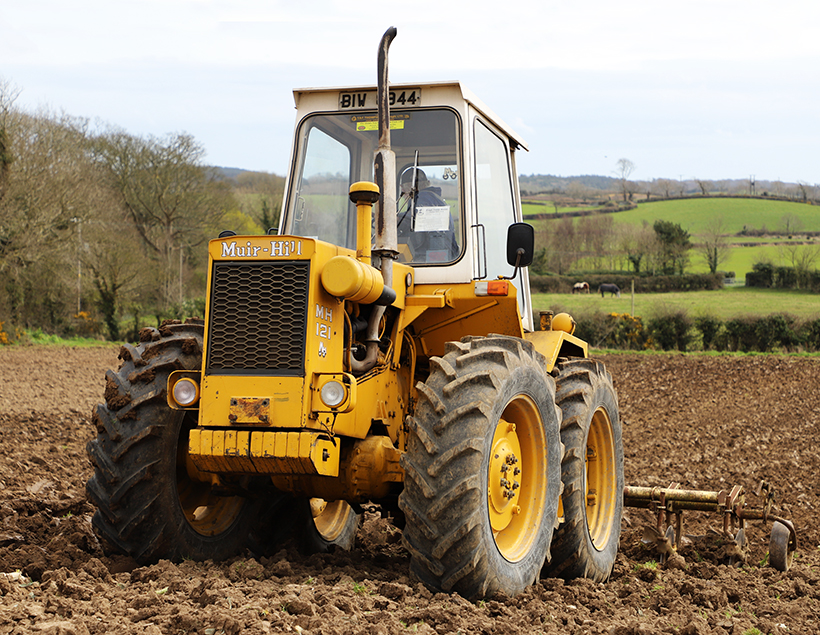
A Bamford five-furrow conventional plough is well within the capabilities of Ken Cooke’s Muir-Hill 121 Series II.
Ken Cooke’s Muir-Hill 121 Series II is now more than 40 years old and is a great example of an original tractor. He uses it for working days, and has also been to tractor pulling events, competing in the standard classic agricultural class, where it performs very well.
Ken’s idea of preservation means working the tractor whenever possible; as he feels this is the best way to keep the tractor in working order. I think he has a valid point. He’s also tested the 121 on his dynamometer, on which it recorded an output figure of just over 90hp at the shaft.
In my opinion, the Muir-Hill tractor was a good machine and it’s a shame that, like so many other famous British tractor manufacturers in the 1980s, the company ceased trading.
With thanks…
I’d like to thank Ken and Isabella Cooke for providing me with an opportunity to look at their M-H 121 in detail, as well as Lloyd Loaders (MH) Ltd, TBF Thompson Ltd, DA Forgie and Malcom Cooke Jnr.
To subscribe to Tractor & Machinery magazine, simply click here




